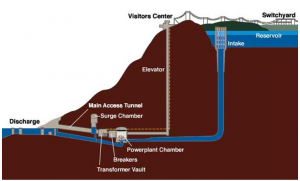Difference between revisions of "Pumped Hydroelectric Energy Storage"
Jump to navigation
Jump to search
| Line 9: | Line 9: | ||
|Has Varieties= | |Has Varieties= | ||
|Has Efficiency Range=70-85% | |Has Efficiency Range=70-85% | ||
|Has Cycle Life=60-100 years< | |Has Cycle Life=60-100 years<sup>1</sup> | ||
|Has Technology readiness level=9 - Fully Mature | |Has Technology readiness level=9 - Fully Mature | ||
|Has Benefits=* Ability to integrate inverter-based renewables | |Has Benefits=* Ability to integrate inverter-based renewables | ||
| Line 20: | Line 20: | ||
|Has Installed Capacity=>160 GW | |Has Installed Capacity=>160 GW | ||
}} | }} | ||
<ref>The world’s water battery: Pumped hydropower storage and the clean energy transition, IHA, December 2018"</ref> | |||
Latest revision as of 16:51, 22 December 2021
- ↑ The world’s water battery: Pumped hydropower storage and the clean energy transition, IHA, December 2018"
